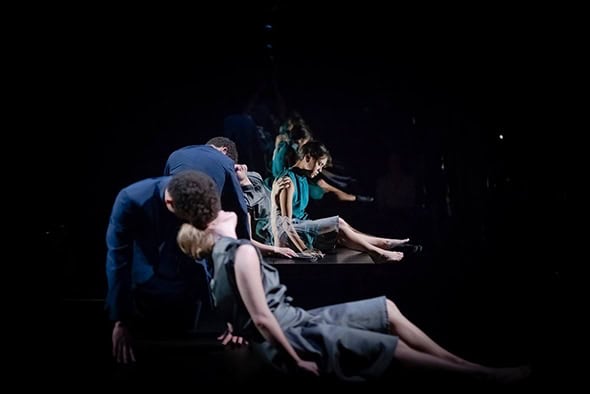National Dance Company Wales in Awakening at Riverfront Theatre
Posted: March 5th, 2019 | Author: Ian Abbott | Filed under: Performance | Tags: Caroline Finn, Fearghus Ó Conchúir, Fernando Melo, Gareth Chambers, Joseff Fletcher, Marcos Morau, National Dance Company Wales, Peter Lundin, Shumpei Nemoto, Yoko Seyama | Comments Off on National Dance Company Wales in Awakening at Riverfront TheatreNational Dance Company Wales: Awakening, Riverfront Theatre, Newport, March 1

Opening their Spring 2019 season, Awakening, in Newport, National Dance Company Wales offers ‘three unique dances to amuse and amaze’. With two premières — Fernando Melo’s Afterimage and resident choreographer Caroline Finn’s Revellers’ Mass — alongside Marcos Morau’s Tundra from 2017 we are welcomed with a five-minute pre-show speech by the new artistic director, Fearghus Ó Conchúir, outlining his support for the ‘brilliant performers’ on stage alongside the plurality of what dance can be and the benefits it offers to our communities, stages and studios across Wales.
Tundra is a 30-minute work for eight dancers that ‘tears pages from the Russian history books on folk dance, mass parades and revolution, revitalising old ideas with renewed meaning. It’s as mesmerizingly beautiful as it is robotically precise.’ If you’re going to self-define to these high expectations then you have to have the skill, discipline and technique to execute; unfortunately the NDCWales dancers do not.
With an air of religious menace in the opening scene we have eight bodies smoothly and footlessly hovering about the stage in competitive Japanese walking patterns, their bell skirts covering their feet as they glide across floor in formations of treacle. This is followed by an attempt at choreographic precision that sits somewhere between a multi-part canon, a pedestrian domino rally and a kaleidoscopic image but executed by more than a quarter of the company surprisingly poorly for a national organisation. If a work demands such a degree of precision and musicality then dancers cannot be one or two beats behind or five degrees out of alignment, especially when Joseff Fletcher’s back-lit lighting exposes and emphasises the exact site of legs, arms and torsos. The discrepancies draw our attention because only five bodies are adhering to the choreographic instruction. Choreographically it is a work full of illusion that succeeds in the front-to-back cluster as we see bodies slowly tipping off balance like pendulums and then reversing back to centre. It’s visually clever and would be more satisfying if it were better rehearsed.
Afterimage by Fernando Melo is a 20-minute work for six dancers that uses the effect of Pepper’s Ghost to make figures appear and disappear in this look at loss, memories and sliding door moments. It describes itself as ‘a journey of fleeting images; of appearance and disappearance. Mirrors are used on stage to form a unique theatrical experience where the past and the present collide with a poetic and creative style of dance.’ Sat at table with two chairs we see encounters between pairs of people who move on and off stage, in and out of light delivering letters from beyond the grave or from another time. Melo’s regular artistic team of Shumpei Nemoto, Yoko Seyama and Peter Lundin make the company look great. It’s a study of simple movement and a bundle of what-ifs that match the stillness, mood and reverence that the work demands.
However if you’ve seen Melo’s work before, Afterimage is essentially a recycling/stitching together of three of his previous commissions for other companies: If walls could speak, Les Enfants du paradis and Pepper’s Ghost. We have the same table, the same chairs, the same mirror, the same mood. As a choreographer for hire this is not unusual; with any commission what you’re getting is a time-limited licence for an existing product and a name that enhances your own brand and gets you into new touring territories.
Finn’s Revellers’ Mass ‘delves into a world of ritual as an unlikely group gathers for a dinner party, where etiquette is put to the test. Curious choreography and characters are inspired by historical paintings.’ Finn’s première for nine dancers is a presentation of Dionysian revelry. There is excess, but for a 30-minute portrayal of a rousing banquet it is just too clean and dainty; no one is letting go. I lack a belief in what is being presented because the dancers don’t appear to believe in what they’re doing: artifice leaks out their bodies and faces. Revelry has to be embodied, as Gareth Chambers showed in his Excess at Chapter last summer where he explored revelry’s sweaty and transgressive relationship to ecstasy and pleasure. Throwing together movement, a hotchpotch of soundtracks, multiple lighting designs and a water-filled trough on stage smacks of choreographic masking. And we need to talk about the ending which cheapens an already lightweight work.
Do I believe in the dancers? Do I believe in what they’re being asked to do and are they able to deliver it? In Afterimage yes, in Revellers’ Mess and Tundra, no. If the financially safest and largest dance company in Wales is presenting apolitical, light, under-rehearsed entertainment at the opening of their Spring season, what message does that send to the rest of the ecology? NDCWales receives a similar amount of public subsidy and operates at a similar scale to Scottish Dance Theatre but the difference in the quality of dancers and choreographic choices is marked; when you’re in receipt of the highest public subsidy the critical lens should be at its sharpest. This triple bill has been inherited by Ó Conchúir (he came into post late last year) and it will be interesting to see how the company moves forward under his artistic leadership.